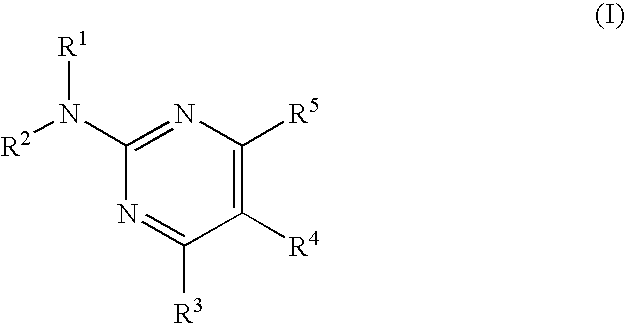Pyrimidine compound and medicinal composition thereof
a technology of pyrimidine and compound, which is applied in the field of new pyrimidine compound, can solve the problems of reducing effectiveness, side effects such as mental symptoms, involuntary movements and mental symptoms, and inability to achieve sufficient therapeutic effects of l-dopa preparations
- Summary
- Abstract
- Description
- Claims
- Application Information
AI Technical Summary
Benefits of technology
Problems solved by technology
Method used
Image
Examples
reference example 1
Ethyl
(E)-3-(3-fluorophenyl)-2-(4-pyridyl)-2-propenoate
[0113]
[0114]A solution of ethyl 4-pyridylacetate (25.0 g, 0.151 mol) and 3-fluorobenzaldehyde (20.7 g, 0.167 mol) in a mixture of acetic anhydride (100 mL) and triethylamine (20 mL) was heated under reflux for 5.5 hours. After standing to cool, the reaction mixture was concentrated. The residue was diluted with ethyl acetate and a saturated aqueous sodium hydrogencarbonate solution, and the aqueous layer was extracted with ethyl acetate. The combined organic layers were washed with a saturated aqueous sodium hydrogencarbonate solution twice and brine, dried over anhydrous sodium sulfate and then concentrated. The residue was subjected to silica gel column chromatography (eluent; hexane, hexane:ethyl acetate=9:1), to give the title compound (25.5 g, 62%) as a red-orange oil.
[0115]1H NMR (400 MHz, CDCl3) δ ppm; 1.28 (3H, t, J=7.2 Hz), 4.27 (2H, q, J=7.2 Hz), 6.70-6.75 (1H, m), 6.80-6.84 (1H, m), 6.91-6.97 (1H, m), 7.12-7.18 (1H, m)...
reference example 2
Ethyl (E)-3-(2-furyl)-2-(4-pyridyl)-2-propenoate
[0116]
[0117]The title compound was synthesized in a similar manner to Reference Example 1 using 2-furaldehyde.
[0118]1H NMR (400 MHz, CDCl3) δ ppm; 1.20 (3H, t, J=7.2 Hz), 4.18 (2H, q, J=7.2 Hz), 6.51 (1H, d, J=3.6 Hz), 6.54 (1H, dd, J=1.6, 3.6 Hz), 7.29 (2H, dd, J=1.6, 4.4 Hz), 7.66 (1H, s), 7.69 (1H, d, J=1.6 Hz), 8.62 (2H, dd, J=1.6, 4.4 Hz).
reference example 3
(E)-4-(2-Furyl)-3-(4-pyridyl)-3-buten-2-one
[0119]
[0120]Under a nitrogen atmosphere, a 3.0M solution of methylmagnesium bromide in diethyl ether (3.7 ml, 11.1 mmol) was added dropwise over 5 minutes to a 1M solution of lithium bis(trimethylsilyl)amide in tetrahydrofuran (22 ml, 22 mmol) at −50° C. (dry ice-acetone bath), followed by stirring as it was for 1 hour. Then, a solution of ethyl (E)-3-(2-furyl)-2-(4-pyridyl)-2-propenoate (2.4 g, 9.87 mmol) in tetrahydrofuran (20 ml) was added dropwise thereinto over 5 minutes. The reaction mixture was stirred for 30 minutes while elevating to room temperature, and then the reaction was terminated by adding hydrochloric acid. After diluting with a saturated aqueous ammonium chloride solution, the mixture was extracted with ethyl acetate. The organic layer was washed with brine, dried over anhydrous magnesium sulfate and concentrated. The residue was subjected to silica gel column chromatography (elution solvent; hexane:ethyl acetate=1:1 to 4...
PUM
| Property | Measurement | Unit |
|---|---|---|
| temperature | aaaaa | aaaaa |
| temperature | aaaaa | aaaaa |
| temperature | aaaaa | aaaaa |
Abstract
Description
Claims
Application Information
 Login to View More
Login to View More - R&D
- Intellectual Property
- Life Sciences
- Materials
- Tech Scout
- Unparalleled Data Quality
- Higher Quality Content
- 60% Fewer Hallucinations
Browse by: Latest US Patents, China's latest patents, Technical Efficacy Thesaurus, Application Domain, Technology Topic, Popular Technical Reports.
© 2025 PatSnap. All rights reserved.Legal|Privacy policy|Modern Slavery Act Transparency Statement|Sitemap|About US| Contact US: help@patsnap.com



